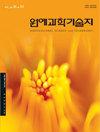Resistance Evaluation of G, CG, or M Series Apple Rootstocks to Soil-borne Diseases (Phytophthora Root Rot, White Root Rot, and Southern Blight) and Woolly Apple Aphid
IF 0.8
4区 农林科学
Q3 HORTICULTURE
Korean Journal of Horticultural Science & Technology
Pub Date : 2021-04-01
DOI:10.7235/HORT.20210015
引用次数: 5
Abstract
In this study, the resistance of the industry-standard M26 and M9 rootstocks and the promising elite G or CG rootstocks was evaluated not only for soil-borne diseases, such as Phytophthora root rot (Phytophthora cactorum), white root rot (Rosellinia necatrix), and southern blight (Athelia rolfsii), but also for woolly apple aphid [Eriosoma lanigerum (Huasm.)]. On February 27, 2019, each unworked rootstock plant was harvested from stool-beds, then planted in 2-L pots and grown in a greenhouse. For P. cactorum, M9 was the most resistant, and CG5087 and G935 were not. There was little difference in susceptibility to R. necatrix among rootstocks, but G or CG rootstocks were generally less susceptible than the M series. The susceptibility to A. rolfsii was higher (p < 0.05) in M series rootstocks than in G or CG series rootstocks, and the mortality reached 80% and 53% for M9 and M26, respectively, and 7% for G935. As a result, M9 and G11 showed resistance to P. cactorum, whereas G or CG rootstocks showed relative resistance to R. necatrix and A. rolfsii. For woolly apple aphid, G11, G202, G214, and CG5087 were immune, but G935, CG4814, M26, and M9 were not. Additional key words: colony, Geneva apple rootstock, mycelium, rootstock infection, soil infestationG、CG、M系列苹果砧木对土传病害(疫霉根腐病、白腐病、南枯病)和苹果蚜虫的抗性评价
在本研究中,不仅评估了行业标准M26和M9砧木以及有前景的优质G或CG砧木对土传疾病的抗性,如疫霉菌根腐病(Phytophthora cactorum)、白根腐病和南部枯萎病(Athelia rolfsii),而且还评估了对羊毛苹果蚜的抗性。2019年2月27日,每株未加工的砧木植物都是从粪便床上收获的,然后种植在2L的花盆中并在温室中生长。对仙人掌的抗性最强的是M9,而CG5087和G935则不然。不同砧木对R.necatrix的敏感性差异不大,但G或CG砧木的敏感性通常低于M系列。M系列砧木对A.rolfsii的敏感性高于G或CG系列砧木(p<0.05),M9和M26的死亡率分别达到80%和53%,G935的死亡率达到7%。结果,M9和G11对仙人掌表现出抗性,而G或CG砧木对necatrix和a.rolfsii表现出相对抗性。对毛苹果蚜,G11、G202、G214和CG5087具有免疫性,而G935、CG4814、M26和M9不具有免疫性。附加关键词:菌落,日内瓦苹果砧木,菌丝体,砧木感染,土壤侵扰
本文章由计算机程序翻译,如有差异,请以英文原文为准。
求助全文
约1分钟内获得全文
求助全文
来源期刊
CiteScore
2.00
自引率
0.00%
发文量
0
审稿时长
1 months
期刊介绍:
Horticultural Science and Technology (abbr. Hortic. Sci. Technol., herein ‘HST’; ISSN, 1226-8763), one of the two official journals of the Korean Society for Horticultural Science (KSHS), was launched in 1998 to provides scientific and professional publication on technology and sciences of horticultural area. As an international journal, HST is published in English and Korean, bimonthly on the last day of even number months, and indexed in ‘SCIE’, ‘SCOPUS’ and ‘CABI’. The HST is devoted for the publication of technical and academic papers and review articles on such arears as cultivation physiology, protected horticulture, postharvest technology, genetics and breeding, tissue culture and biotechnology, and other related to vegetables, fruit, ornamental, and herbal plants.

 求助内容:
求助内容: 应助结果提醒方式:
应助结果提醒方式:


